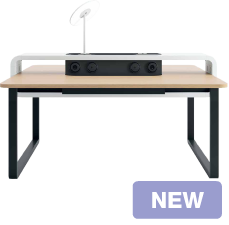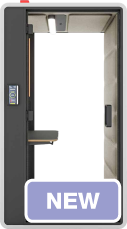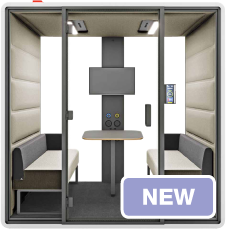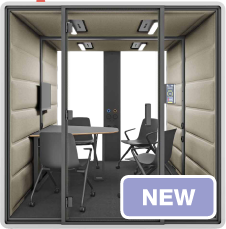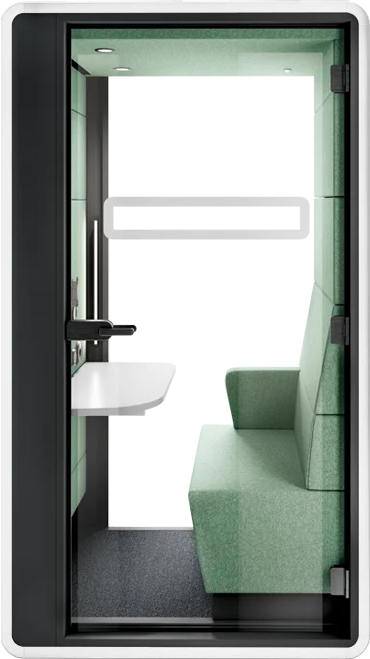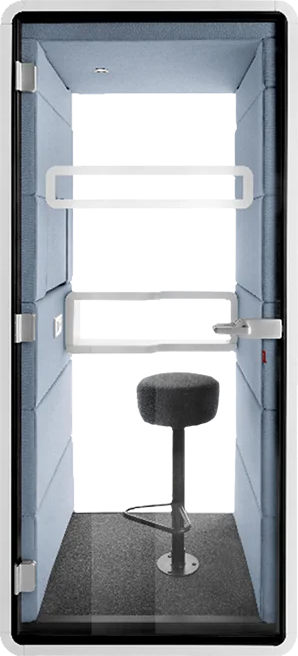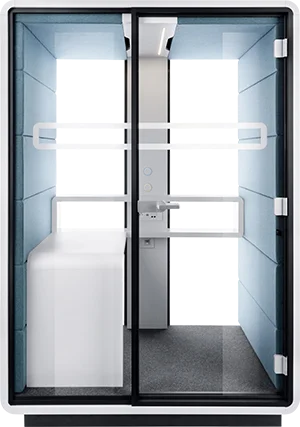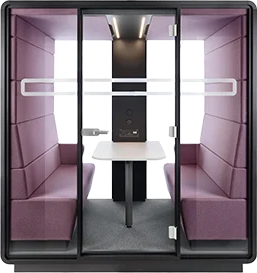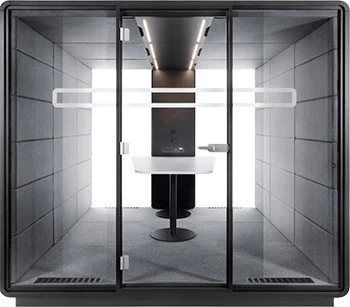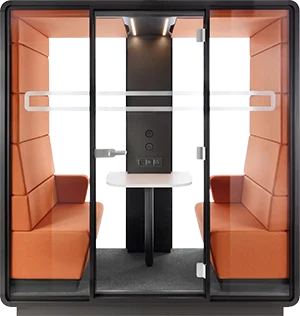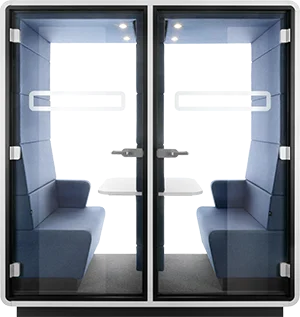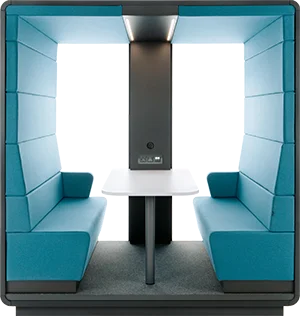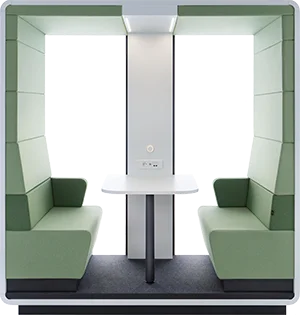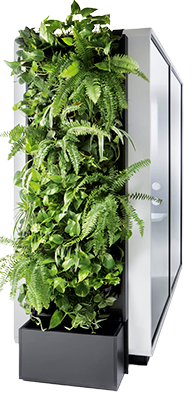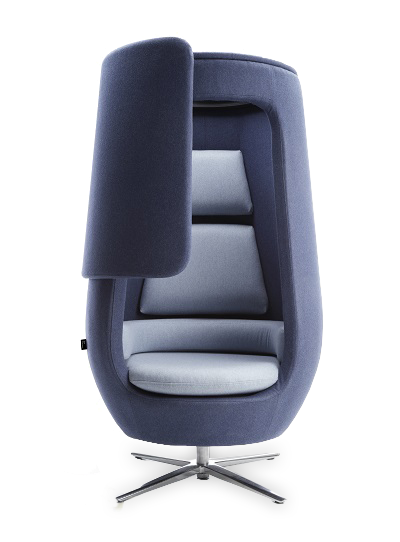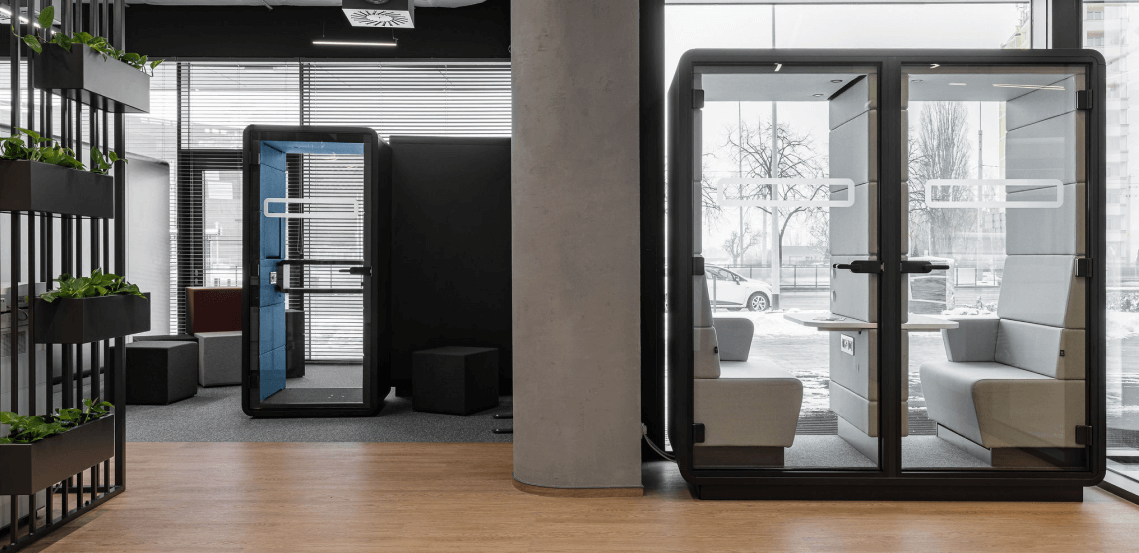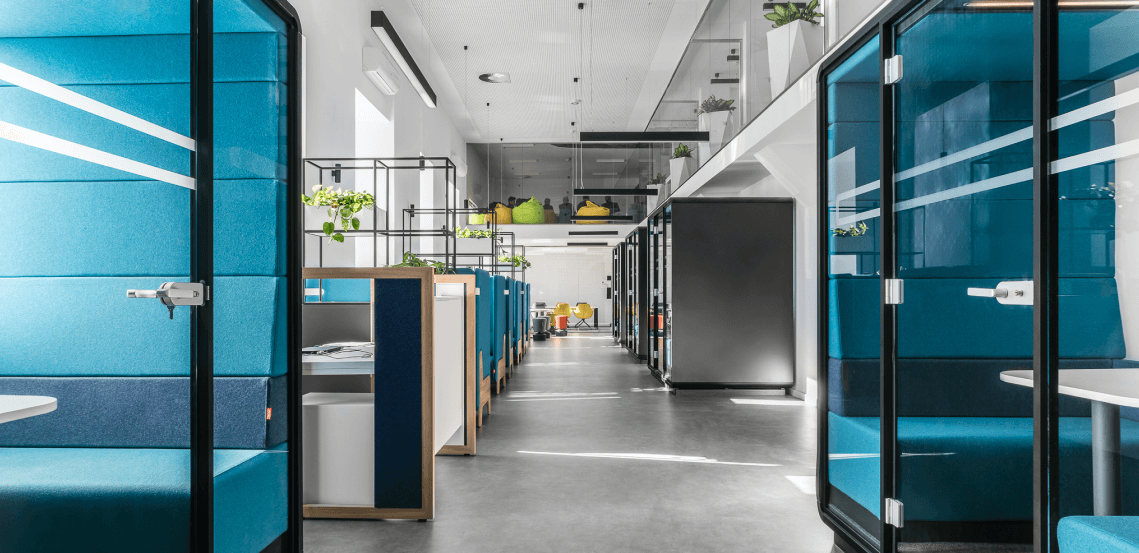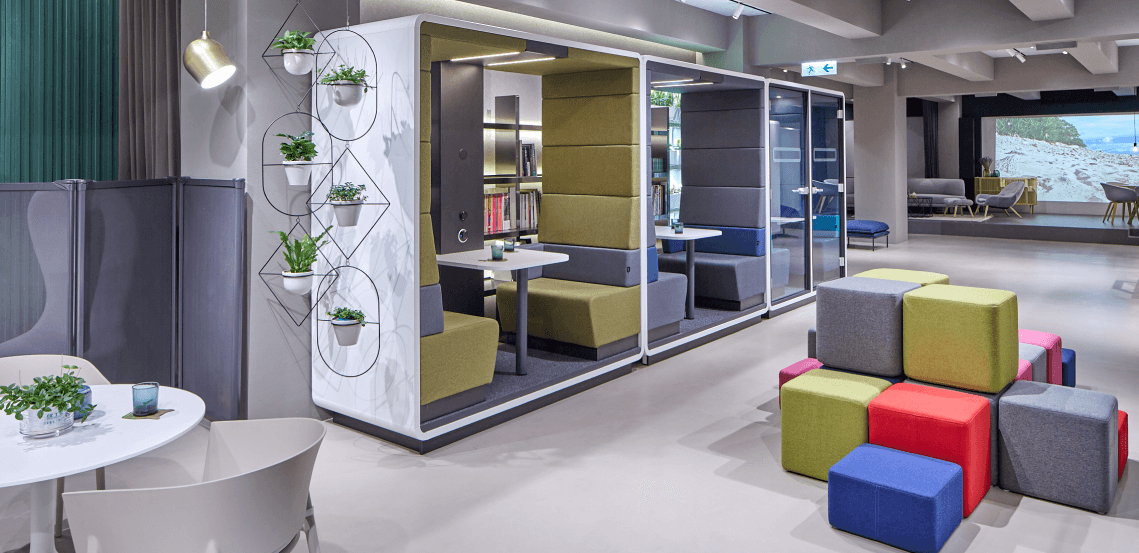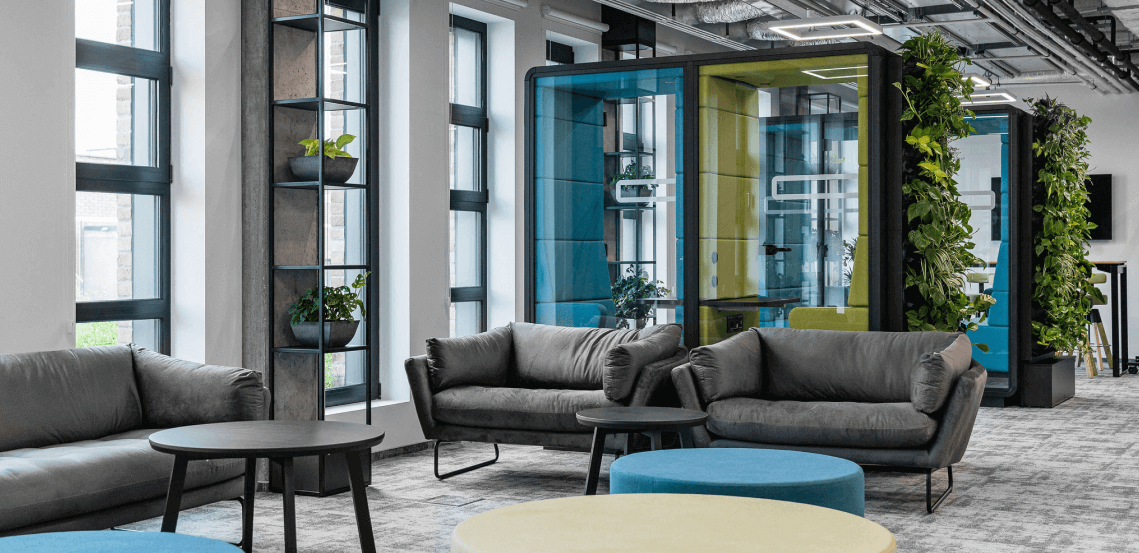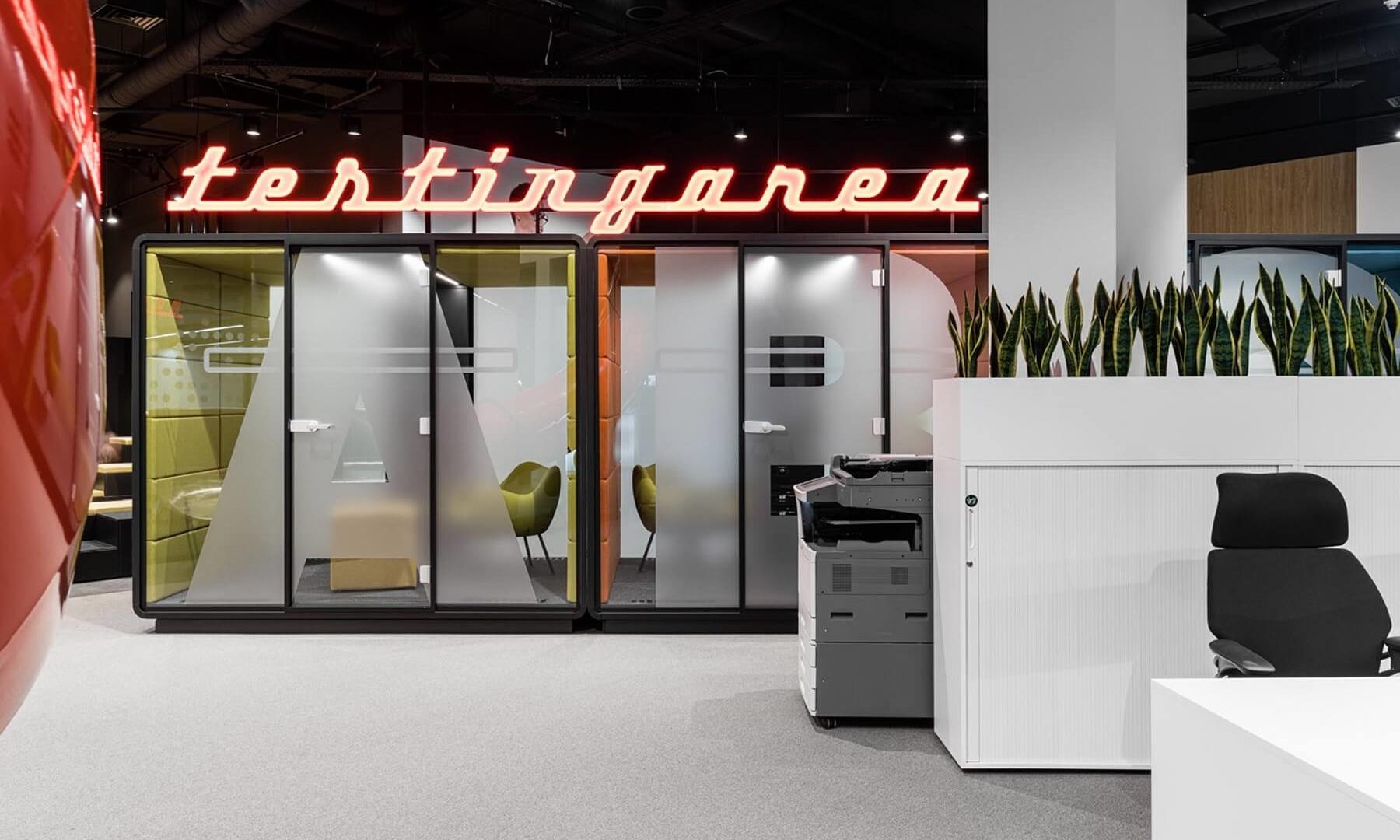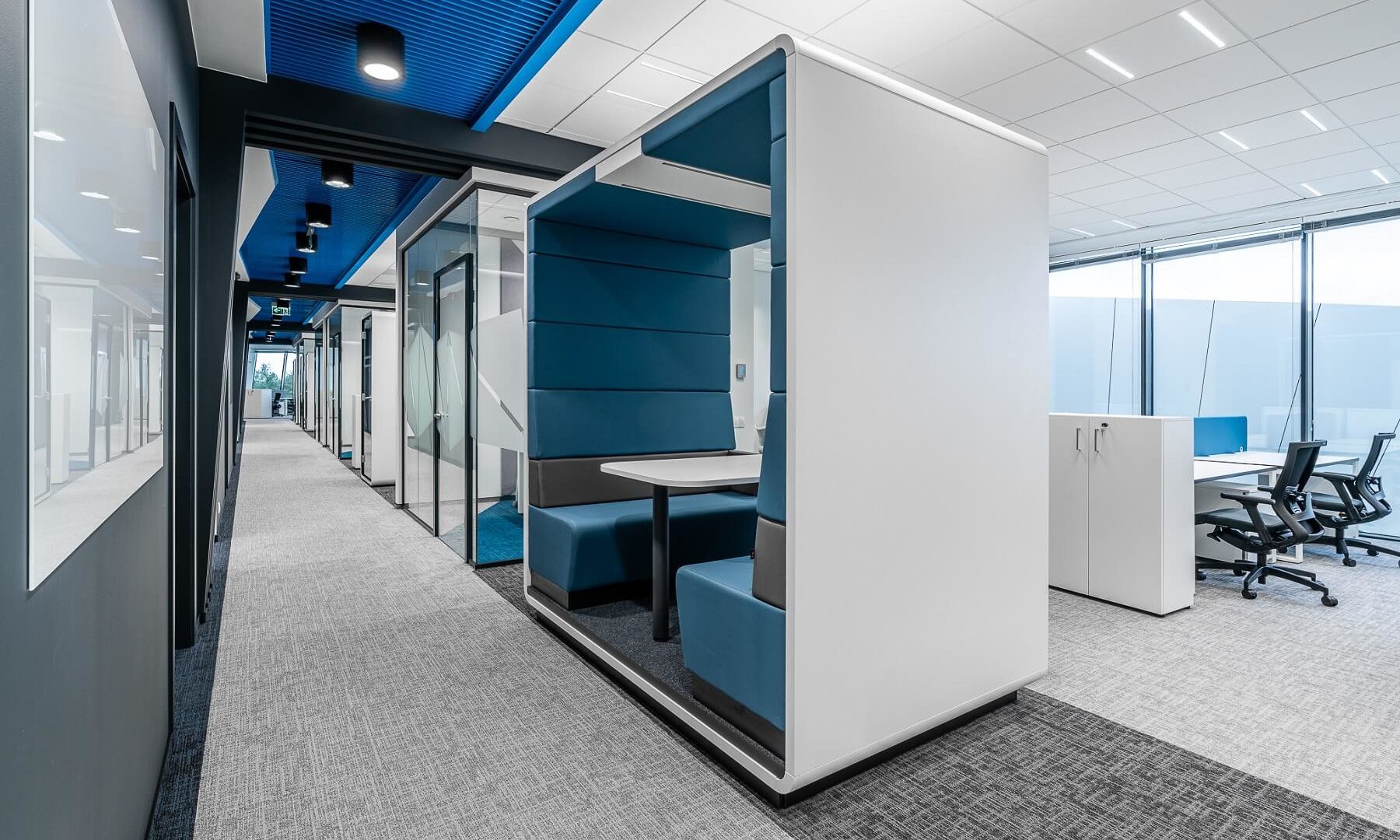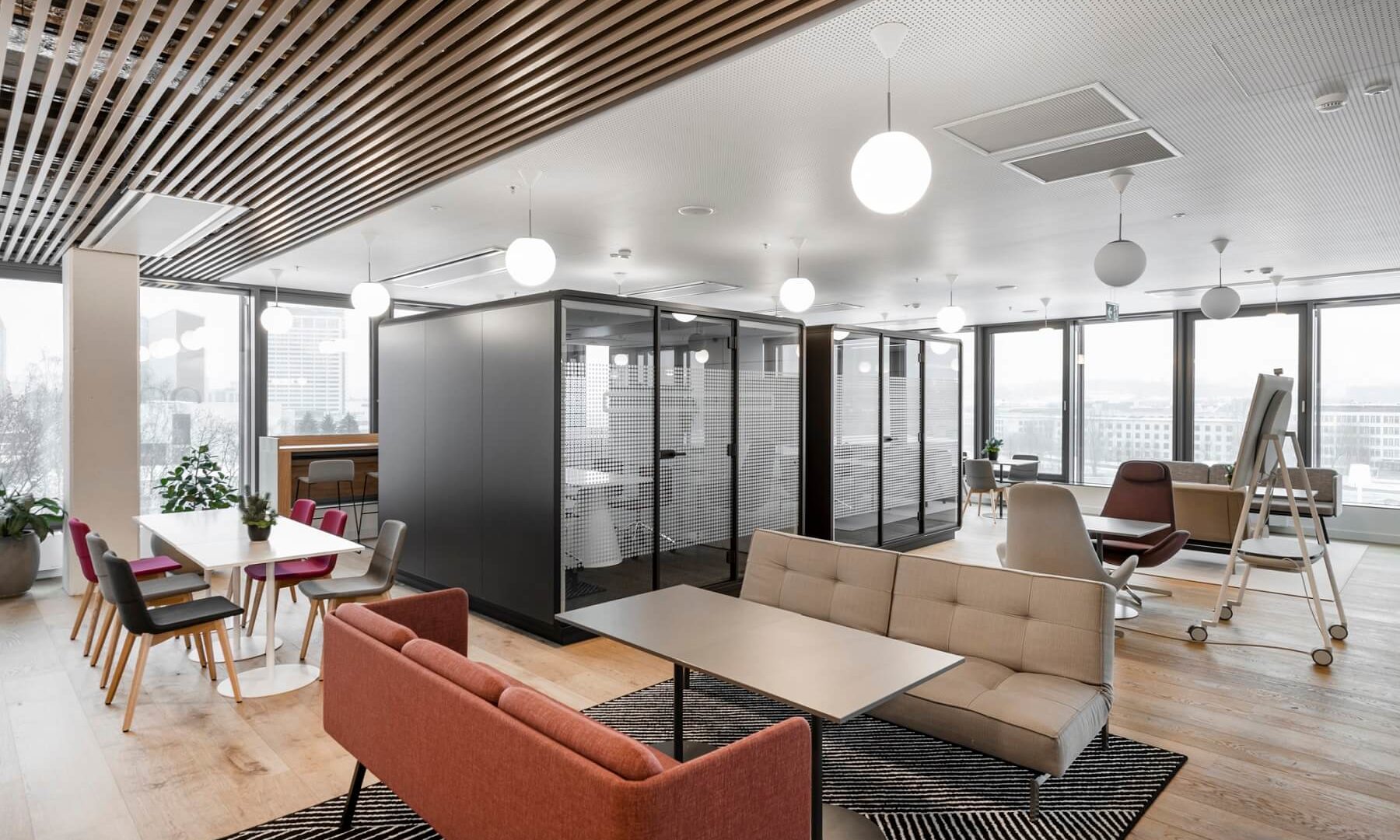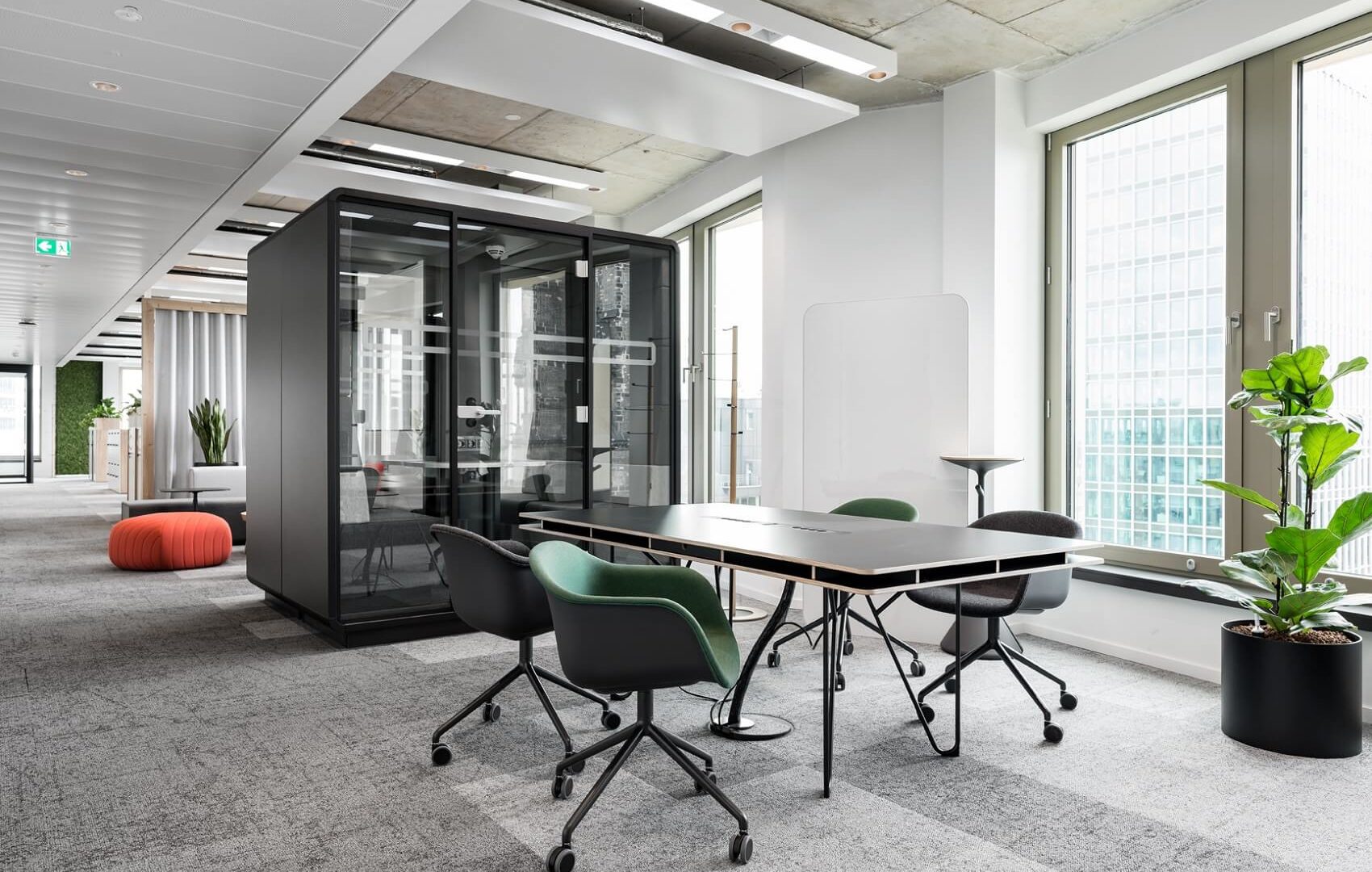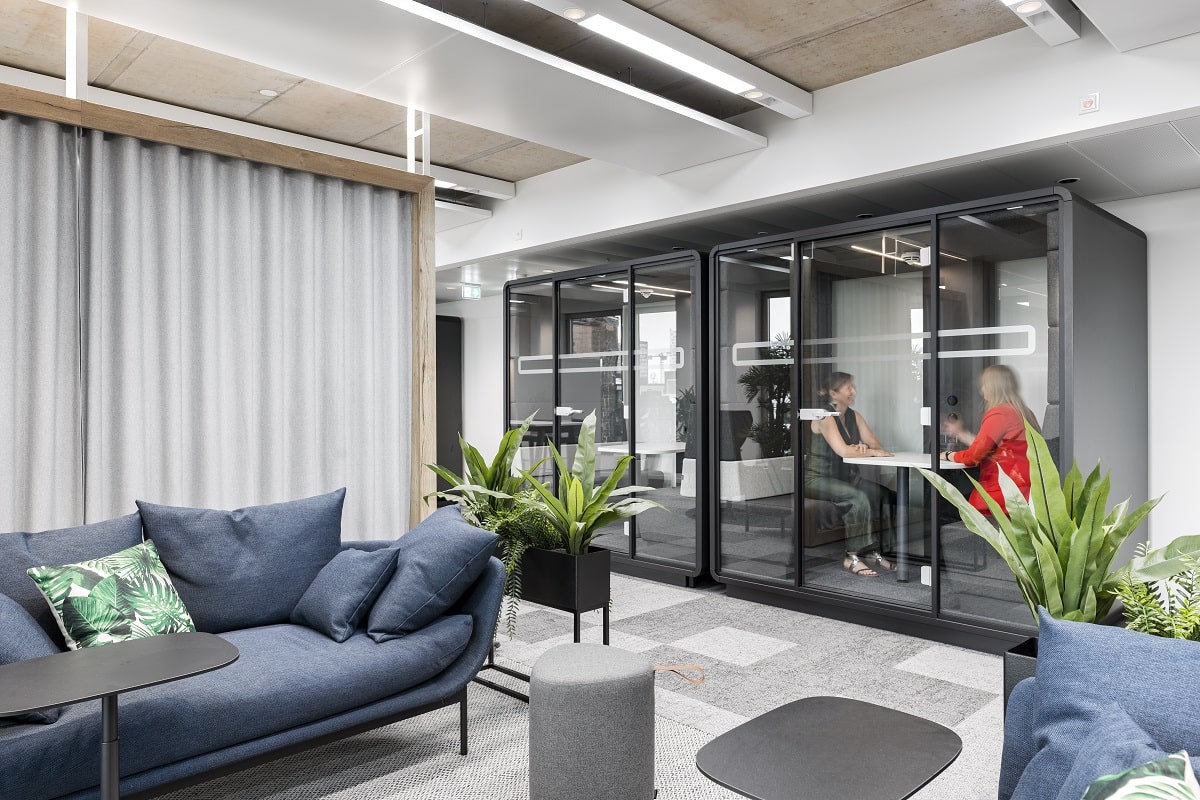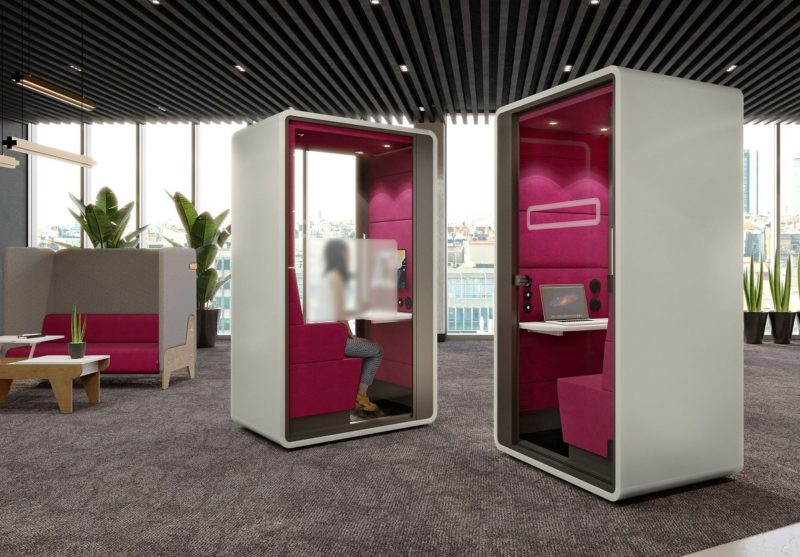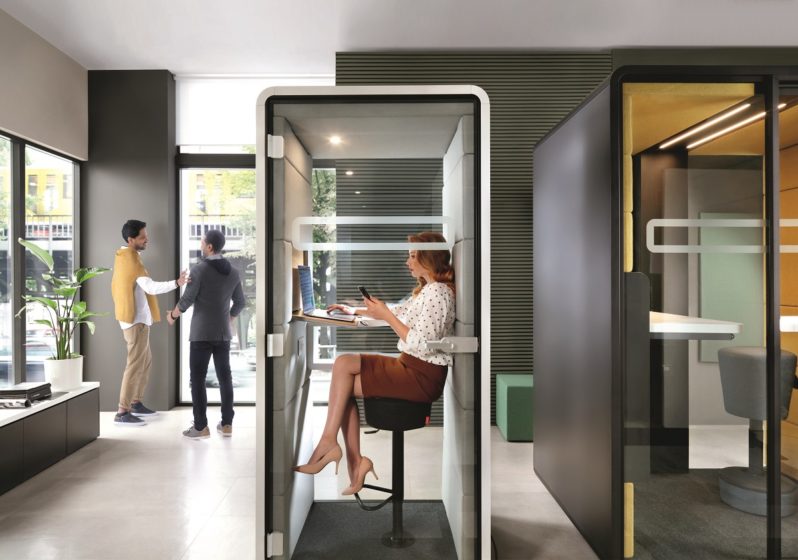3 vital types of privacy in open floor plan explained: acoustic, visual, architectural
- Posted on: 9 February 2022
- By: Hushoffice Team
Office privacy is multifaceted. It breaks down into acoustic, visual, and architectural privacy in open floor plan. All three matter, impacting performance and wellness. We dug deep into each one to give you granular guidance: boosting office privacy in open-plan spaces.
Privacy in open floor plan – key takeaways:
Privacy is a matter of control. Having control over all the sensory stimuli that make your environment what it is (light, sound, visuals). And mastering workplace privacy requires a mix of “open” and “closed” zones. This is because the human needs for socialization and isolation are counterparts.
Preferences regarding acoustic, visual, and architectural privacy vary greatly, employee to employee. With an array of distinct environments to pick from, people naturally choose the one that meets their needs. Hence variety is key.
Acoustic privacy has two dimensions: freedom from intrusive background office noise and freedom from being overheard. The three best solutions to boost acoustic privacy are sound machines, work pods, and space-dividing noise-absorbing partitions.
Visual privacy also has two dimensions. Firstly, visual distractions are blocked from the employee’s view. Secondly, this employee is shielded from others’ prying eyes. Must-have solutions for visual privacy on an open-plan layout include privacy filters, desktop partitions, and glass films, stickers, or graphics.
Architectural privacy is the degree to which a built space physically encloses occupants. The basic idea is to allow employees to seclude themselves to the degree they find most comfortable. Here, too, partitions, structural rooms, and quiet pods for offices help.
What is the essence of privacy in the workplace?
It’s all about control, balance, and variety.
Privacy in open floor plan is a matter of control.
Or having control over your environment. More specifically, having control over all the sensory stimuli that make your environment what it is. Stimuli like light, sound, and visuals. An employee’s sense of privacy in their immediate space hinges on their ability to control, block out, or adjust these stimuli.
When an employee is inundated with sensory input, their privacy is violated. On the other hand, when they’re too separated from the office’s activity, they feel marooned. Thus, privacy is a balancing act. And it’s very individual
– lends Mateusz Barczyk, Senior Brand Manager, Hushoffice.
Mastering it requires a mix of “open” and “closed” zones. Or “active” and “calm.” Or “public” and “private.” This is because the human needs for socialization and isolation are counterparts. Like yin and yang, they’re complimentary.
Most people crave socialization as often as they crave isolation, just at different times.
We see this play out plainly at work. Employees shift intermittently between needing to be stimulated by people and needing to hunker down in a frenzy-free space. They exhibit an ebb and flow. The office’s mix of “open” and “closed” spaces must accommodate this ebb and flow.
Preferences regarding acoustic, visual, and architectural privacy vary greatly, employee to employee.
People are unique. Some people are generally sensory-seeking. Some are generally sensory-avoiding. Some are neurodivergent and easily agitated by commotion. Some get lonely without it
– adds Mateusz Barczyk, Senior Brand Manager, Hushoffice.
Therefore the most inclusive, universal design is one that gives employees options. More specifically, a variety of zones, each zone delivering a unique degree and quality of overall privacy.
With an array of distinct environments to pick from, people naturally choose the one that meets their needs.
Whether that’s a need to be energized by others or restored by refuge. Able to satisfy each need, employees aren’t finding themselves regularly violated by an excess of stimuli or isolated by a lack thereof. Instead, they’re harmonizing with the zones they inhabit. The important thing is to make each zone distinct in terms of acoustic, visual, and architectural privacy. That being said, let’s clarify what each of these is.
What is acoustic privacy?
Acoustic privacy has two dimensions. Firstly, the employee has freedom from intrusive background office noise. So they aren’t sidetracked by coffee machines and conversations. Secondly, they have what’s called speech privacy, or freedom from being overheard by others.
With acoustic privacy, employees enjoy muffled speech in a quiet space.
They’re able to talk openly, and they’re able to create all the noise they want. Speech privacy is sometimes called information security, acoustic confidentiality, or confidential privacy.
Acoustic privacy is a performance driver.
One employee can’t grasp complex processes unless they talk it through out loud to themselves. But they feel awkward doing so on the open floor. Their workflow is thus limited by a lack of acoustic privacy. Another employee gets excited every time they brainstorm new funnels. To restrict their rowdy enthusiasm would restrict their creativity.
Eliminate noise, elevate focus.
A third employee can’t make sense out of data unless they’re deep in concentration. And a noise-free space is a prerequisite to this, given how their brain works. These three common cases illustrate the elemental. Acoustic privacy influences performance in a real, measurable way.
One landmark study confirms bad speech privacy is the #1 source of employee dissatisfaction.
This is concerning, knowing that poor noise conditions are proven to have a significant impact on employee health and wellness. In fact, a study from 2000 definitively shows that workplace noise negatively affects perceived stress levels as well as the presence of stress hormones in employees.
Lack of acoustic privacy can affect neurodivergent employees more negatively.
Neurodivergent people process sensory input differently from the average person. They are either hyper- or hypo- sensitive to stimuli, making them more susceptible to their surroundings.
Employees with ADHD, for instance, are often more easily deterred by background noise.
While employees with dyslexia sometimes struggle to discern speech in noisy spaces. Read more about this ever-important topic: Office design for a neurodiverse workforce.
Speech privacy is non-negotiable for many reasons.
It protects confidential, sensitive, or private information. In a meeting, specifically, it allows attendees to share without concern of valuable information leaking. This can include trade secrets, intellectual property, and litigation. Speech privacy is therefore crucial if your company is guarding creative assets.
Speech privacy protects delicate conversations.
Like the kind held between HR managers and employees. And on calls, it helps people tune into conversation, assured they aren’t being eavesdropped upon. Job function to job function, department to department, private speech is essential.

Each soundscape in the office should provide a target level of acoustic privacy.
Varying office functions have varying acoustic needs. Conference meetings, for instance, need acoustic confidentiality and zero background noise. Focused work generally flourishes in a 40dB soundscape, the level proven most conducive to deep focus. Collaborative activities tend to benefit from a more active environment. This is partly because 70dB is the proven sweet spot for creativity.
And all activities should be acoustically contained by acoustic office pods.
Or absorbed by sound-dampening treatments like dividers and baffles. This way, office noise is managed, never flooding the floor.

3 solutions to boost acoustic privacy in open floor plan: noise machines, soundproof partitions, and work pods.
When done artfully, space division can give an office space adequate privacy without compromising its open nature
– offers Mateusz Barczyk, Senior Brand Manager, Hushoffice.
Sound machines improve both facets of acoustic privacy. They work by producing a generative, pleasant noise that covers the irritating, unpleasant one. The space is therefore perceived as quieter. The addition of a masking noise also reduces the radius of distraction or distance at which speech is intelligible from the source.
Space division is a way to create multiple soundscapes, giving employees options. Space division prevents sound from leaking from one zone to the next. So each zone has acoustic privacy. Furthermore, you can create multiple zones with varying acoustic environments or soundscapes. By offering multiple soundscapes in the office, you cater to those varying preferences and needs. Some employees just need a louder space to get into their element, while some need library-quiet for every task. Variety accommodates these differences.
Acoustic office pods trap noise, giving the users speech privacy while preventing their noise from bothering others. Pods are a strong solution because their acoustics benefit is multidimensional. They give the pod user a flawless soundscape for the specific task at hand. Be it a phone call within hushPhone or a video call within hushHybrid. Simultaneously, they trap the user’s noise, stopping it from perturbing the open floor. This results in a more ambient soundscape for the whole workplace, both inside and outside of the pod.
Read more: The quick, comprehensive guide to office noise.
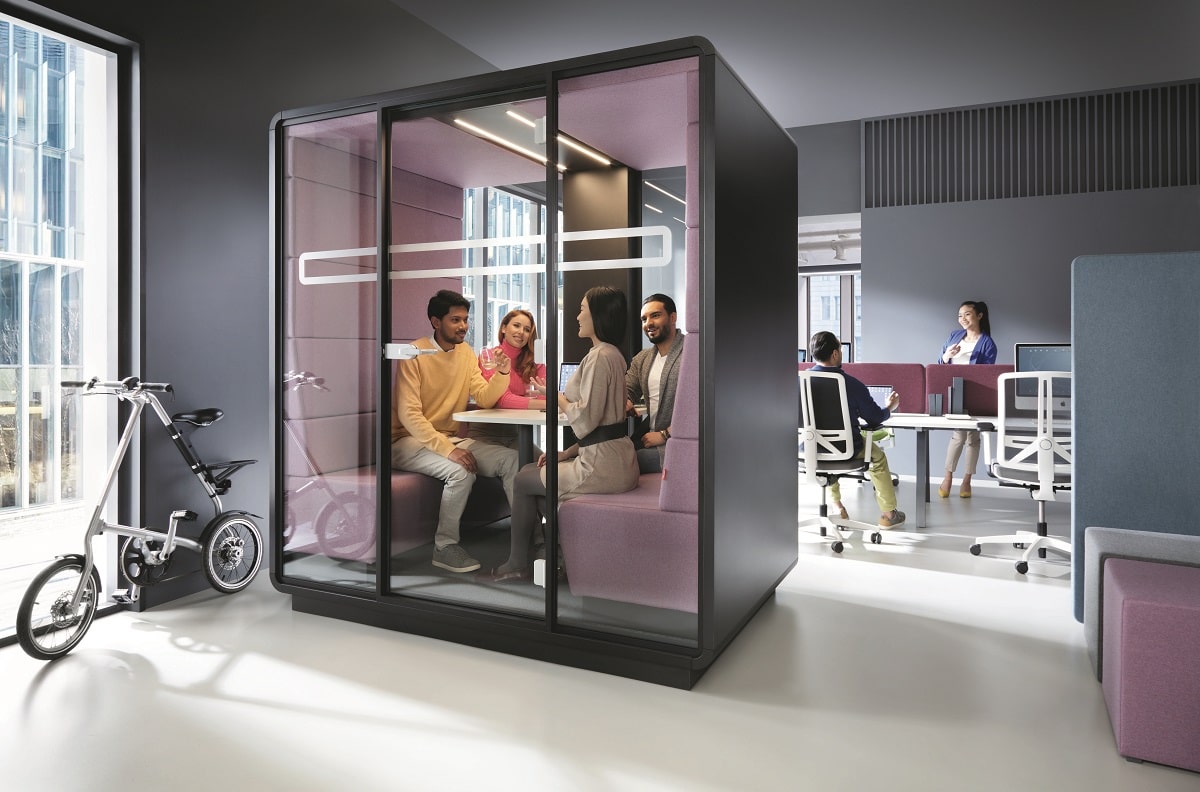
What is visual privacy?
Visual privacy or visual confidentiality in the office also has two dimensions. First, visual distractions are blocked from the employee’s view. Second, this employee is shielded from others’ prying eyes.
When an employee has visual privacy, they’re neither upset by movement around them nor do they sense they’re on display.
As a result, the employee feels secure and at home in their space. They are able to simply focus on their work, untroubled by the office beyond it.
Inadequate visual privacy can wreak havoc in a number of subtle ways.
Employees might be interrupted every time a colleague walks by their desk. These interruptions add up. Or perhaps a team is holding a meeting on the floor (because they have no conference rooms or acoustic meeting pods like hushMeet). In this case, attendees are liable to be more preoccupied with background hustle-and-bustle than the meeting itself.
Without a private meeting space, visiting clients and partners are likely distracted by the office’s activity.
Which leaves a bad impression. In other cases where visual privacy is insufficient, employees may be insecure mapping out new ideas on the rolling whiteboard, for instance. They may fear being judged, what with their thoughts on display for all to see.
Without solutions like desktop dividers, people have no defined personal space.
They may worry about a colleague reading a private email or other sensitive information on their laptop. Or they may be unable to work on confidential material in the office.
Employees may be stressed out by the sense they’re constantly supervised.
In addition, it may take them longer to complete tasks because random office action is always breaking their attention. Ultimately, they may leave work exhausted by having mentally blocked out stimuli all day.
Note some people sway to and fro, swivel, or nod along to music when focused.
This works for them but can be bothersome for others. Improving visual privacy would fix this. Another unfortunate possibility of this scenario is that such employees who benefit from periodic movement restrict their movement, worried of being judged. They then put a cap on their productivity.
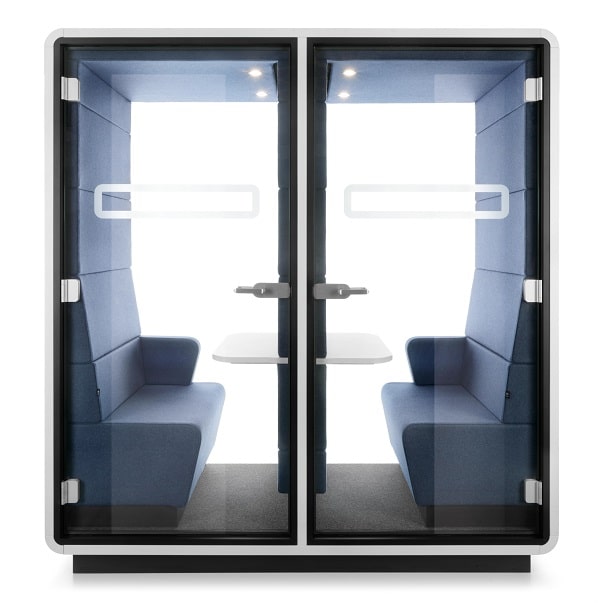
Light- and color-related visual irritants are also problematic.
Glare, flickering fluorescents, stimulating patterns, and color choices all aggravate the eyes. Digital eye strain can result in time. This is uncomfortable, and it’s also an ergonomic hazard to employee health.
Harsh, distracting light can hinder a neurodivergent employee’s success.
Employees with dyspraxia, for instance, may be highly sensitive to light in some cases. This means the flickering fluorescents or harsh monitor glare is not only a headache but a hindrance to their success.
3 solutions for visual privacy in open floor plan: privacy filters, desktop partitions, and glass films.
Privacy filters for devices. Inexpensive and effective. Screen privacy filters shield monitors from all side angles. So colleagues to the left and right won’t be able to see an employee’s personal screen.
Freestanding desktop privacy screens. Minimal and mobile. Like horse blinders that block out attention-breaking stimuli on all sides. Freestanding desk dividers are available in every imaginable height and every imaginable material. Acoustic models absorb sound, imparting better office acoustics, too.
Frosted, matte, or opaque glass films, stickers, and graphics. A foolproof, economical way to boost visual privacy without diminishing an office space’s open quality. Films, stickers, and graphics are also temporary and can be quickly removed or replaced as tastes change.
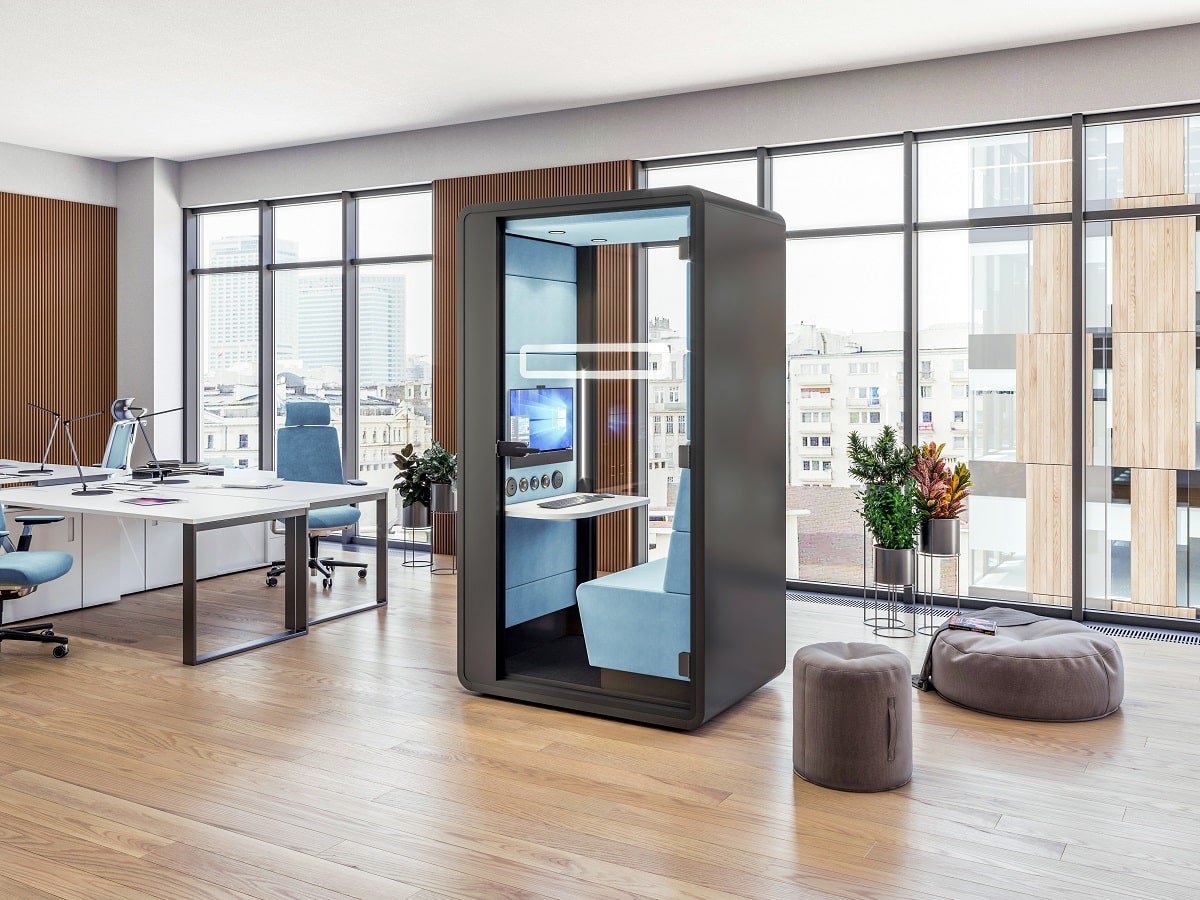
What is architectural privacy?
Also called physical privacy. Architectural privacy is the degree to which a built space physically encloses occupants.
Architectural privacy lends a pleasant sense of being cocooned.
This helps employees get comfortable in their zone. It’s similar to territorial privacy, or the ability to claim and control one’s personal space.
Architectural privacy plays out in different ways for different people.
As an example, some employees work just fine with their backs open to the office. Others get stressed out set up this way, preferring their back be against a wall. Some prefer a totally enclosed workspace, one that shelters them on all sides. Some love the open aspect of the open floor full stop.
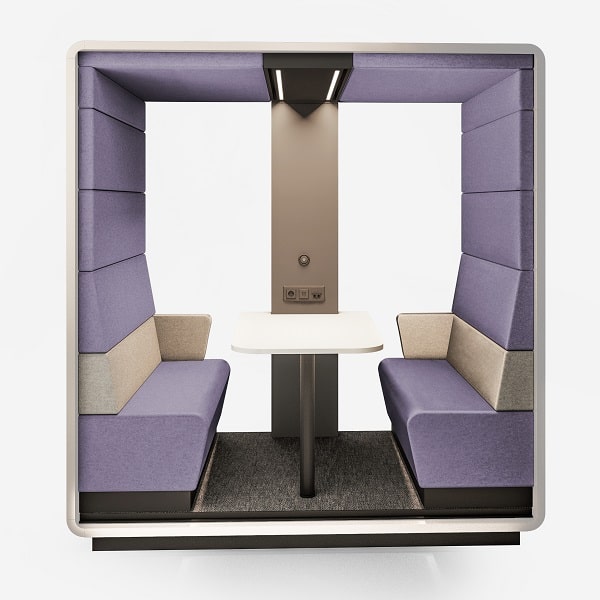
Neurodivergent people typically need a strong security in their space.
Which is influenced by their ability to control it. The varying cases illuminate a necessity for various office environments. With various environments to choose from, people can separate and/or enclose themselves to the most comfortable degree.
There are clear-cut symptoms of inadequate architectural privacy in open floor plans.
In cases where architectural privacy is lacking, sensitive employees may be on edge at most times, braced for their space to be intruded upon. Anxiety can ensue. They may be losing energy tracking their surroundings all day. Some can actually be frightened, too, in the instance that a colleague pops by, ejecting them from concentration. So there are clear stress components.
When an employee isn’t grounded in their space, they’re uneasy.
They’re unable to orient themselves, settle in, and focus. What’s more, they can’t communicate “do not disturb” because they can’t separate themselves physically. So others will approach at will, not aware that they wish to be left alone for the moment.

Architectural privacy is a sense.
And it boils down to safety — a primal need. It affects people on an emotional, psychological basis. So it can single-handedly undermine well-being.
The basic idea: allow employees to seclude themselves to the degree most comfortable for them.
As emphasized, we don’t want to cut people completely off from one another. We want to give people the ability to isolate themselves to the degree best for them. This is where private office work pods like hushWork.sit&stand and mobile meeting pods like hushMeet can serve. Pods are mobile, freestanding oases of calm. Each pod is built for a specific work function. So each pod gives employees an ideal privacy experience for the moment’s task.
Office cabins realize the open-plan concept by bringing privacy and choice back.
They don’t compromise the open, connected aspect of the open floor — they complete it. Select models from the Hushoffice collection can inspire you should you begin rethinking your office’s privacy. Starting out, consider the hushHybrid one-person video conference booth or the hushPhone private phone booth. Both feature adjustable, continual ventilation for maximum thermal comfort.
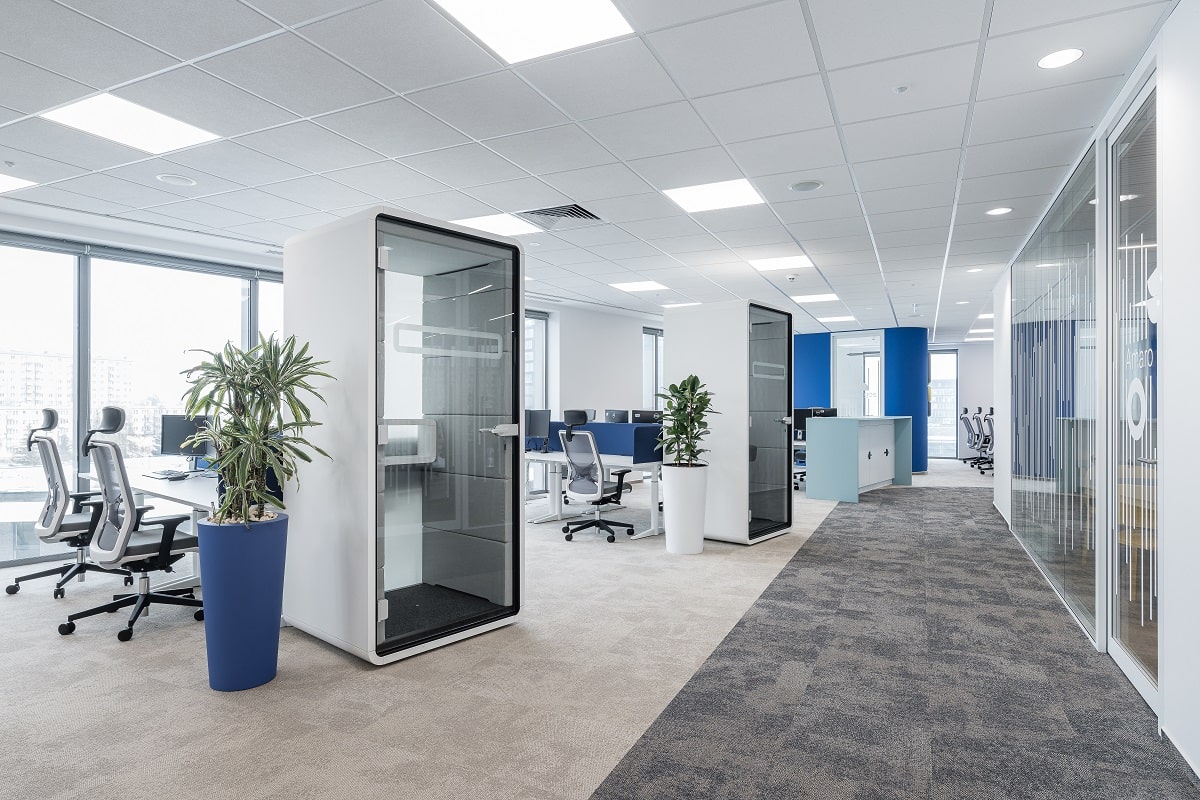
Booths like the hushTwin portable privacy pods are game-changers for the sensory-avoidant.
They cocoon. They give the user a personal space to control. And they fit into tight nooks, getting maximum function out of minimum square footage. The hushMeet meeting pod is another contender, giving privacy to 4-person team meetings. Its central column is the perfect place to hang a monitor. Hop in, let content drive, recap, break. Enjoy the forward momentum.
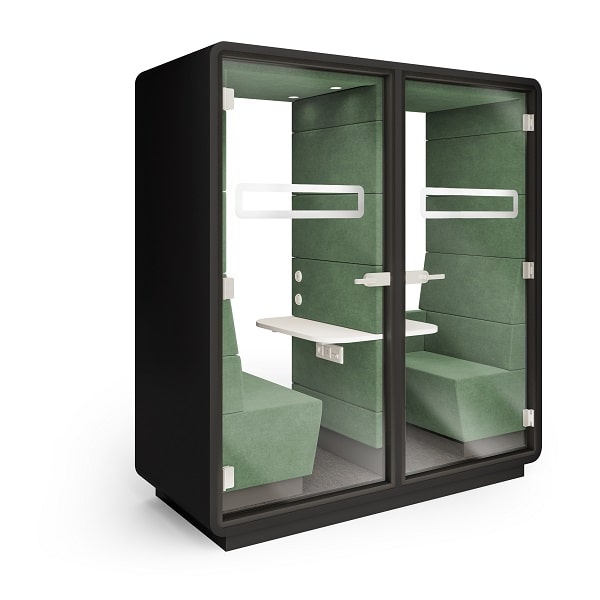
The hushMeet.S 2 person meeting pod is a smart consideration if your team holds regular one-on-ones.
It’s compact, and it’s fully equipped. HushMeet.S’s dimmable lights allow users to tweak luminescence to suit their preferences. If larger meetings are frequent, check out the hushMeet.L modular meeting pods. HushMeet.L can be expanded or scaled back by modules to accommodate between 4-8 people. It’s an adaptable, easy-to-relocate alternative to structural rooms.
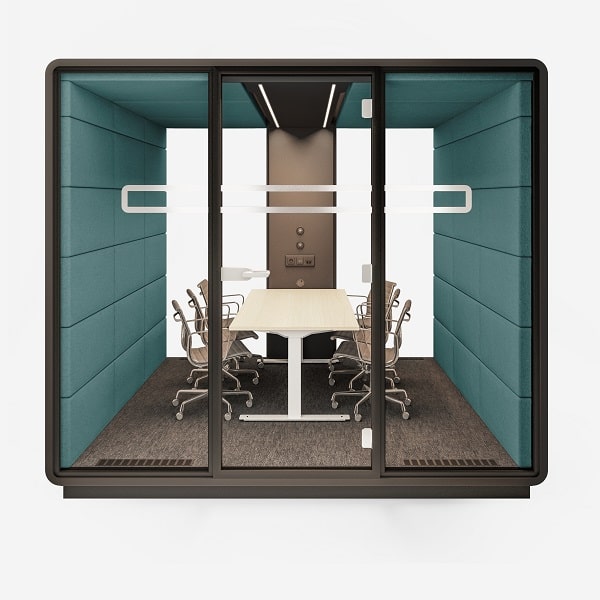
Curious what it’s actually like to use a private work pod? Here’s a read for you: Private pods. What does privacy actually feel like in an office pod?
Portable office pods are a 3-for-1. One pod. All three kinds of privacy.
Finely soundproofed. Physically enclosing. Built to block out disturbances, both acoustic and visual. Mastered for speech intelligibility and speech privacy. Office booths and pods deliver all three vital kinds of privacy. They’re special because they’re freestanding, making the layout flexible. They turn a rigid office into a mobile one.
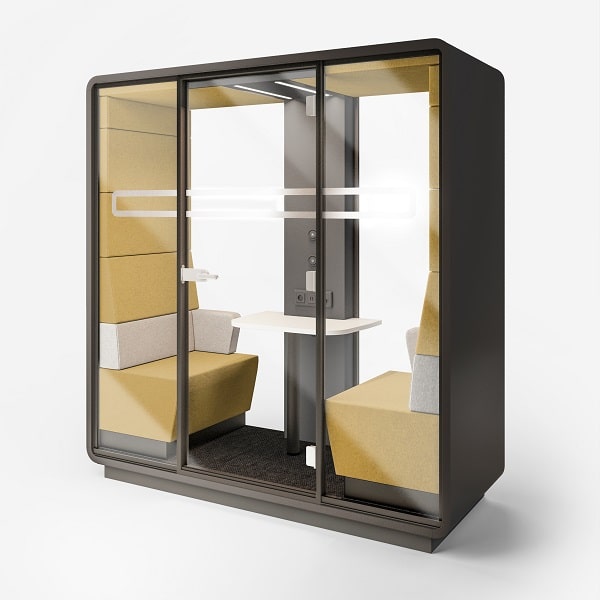
11 signs acoustic pods are the right solution to provide privacy in open floor plan
-
You’ve implemented sound-proof room dividers, but they don’t give enough acoustic privacy — intelligible speech is still permeating the space, distracting employees.
-
You don’t have enough areas in the office for confidential discussions.
-
Premium meeting rooms are always occupied, leaving colleagues flustered and forced to hold meetings on the floor.
-
Employees complain of tiresome background office noise or activity.
-
You need more private work and meeting spaces but infrastructure isn’t feasible.
-
You’ve invested in noise-insulating treatments like panels, baffles, and screens, but they don’t absorb enough sound from ad hoc meetings, so the floor is still a bit noisy.
-
You don’t have enough quiet areas for phone calls.
- Some employees get stressed out or anxious on the open floor because they have little control over their environment there (its sights, sounds, movements).
-
Focus is often fractured by conversations — halfalogues, chatter, collaborative racket, and the like.
-
Though your office white noise machine has reduced speech intelligibility, making the floor more peaceful, your team still wants soundproofed spaces where they can collaborate loudly and freely.
-
Employees feel self-conscious or hyper-vigilant when working on the open floor because they sense they’re under constant supervision.
Acoustic, visual, and architectural privacy are interrelated.
Which is good news! Because it means many office privacy solutions are versatile, unlocking multiple benefits at once. Thus, by boosting one of the three vital types of privacy, you often boost the other two as well. It’s all a matter of thought, creativity, and the right solutions.
Privacy in open floor plan – summary:
Privacy is a matter of control. Having control over all the sensory stimuli that make your environment what it is (light, sound, visuals). And mastering workplace privacy requires a mix of “open” and “closed” zones. This is because the human needs for socialization and isolation are counterparts.
Preferences regarding acoustic, visual, and architectural privacy vary greatly, employee to employee. With an array of distinct environments to pick from, people naturally choose the one that meets their needs. Hence variety is key.
Acoustic privacy has two dimensions: freedom from intrusive background office noise and freedom from being overheard. The three best solutions to boost acoustic privacy are sound machines, work pods, and space-dividing noise-absorbing partitions.
Visual privacy also has two dimensions. Firstly, visual distractions are blocked from the employee’s view. Secondly, this employee is shielded from others’ prying eyes. Must-have solutions for visual privacy on an open-plan layout include privacy filters, desktop partitions, and glass films, stickers, or graphics.
Architectural privacy is the degree to which a built space physically encloses occupants. The basic idea is to allow employees to seclude themselves to the degree they find most comfortable. Here, too, partitions, structural rooms, and quiet pods for offices help.
Privacy in open floor plan – FAQs
How do you build privacy in open floor plan?
Privacy is acoustic, visual, and architectural. Boost acoustic privacy using sound machines, work pods, and space-dividing noise-absorbing partitions. Boost visual privacy using privacy filters, desktop partitions, and glass films. Boost architectural privacy using structural rooms and enclosed office pods.
What are the best office privacy pods?
The best pods for office privacy are acoustic ones. They should protect speech privacy while blocking out office noise. Mobile booths are best because they give the layout moldability. Opt for models with adjustable lighting and ventilation so employees can enjoy the most comfortable environment. Convenience is the primary factor. Consider Hush pods which are fully furnished and fully equipped for specific work functions — say independent work (see: hushWork.sit&stand office privacy booths) or 4-person team meetings (see: hushMeet meeting booths for offices).
What are office privacy booths?
Office privacy booths like the Hush office pods are prefab, freestanding work, meeting, and lounge spaces. They’re acoustically engineered for specific work functions, whether it be video calling in the hushHybrid video calling booth or attending a quarterly performance review in the hushMeet.S 2 person booth. Privacy booths also give employees visual and architectural privacy. How? They’re physically enclosing, blocking out visual distractions while shielding the pod user from others’ views. As a result, the employee feels secure and at home in their space. Productivity naturally flows.








